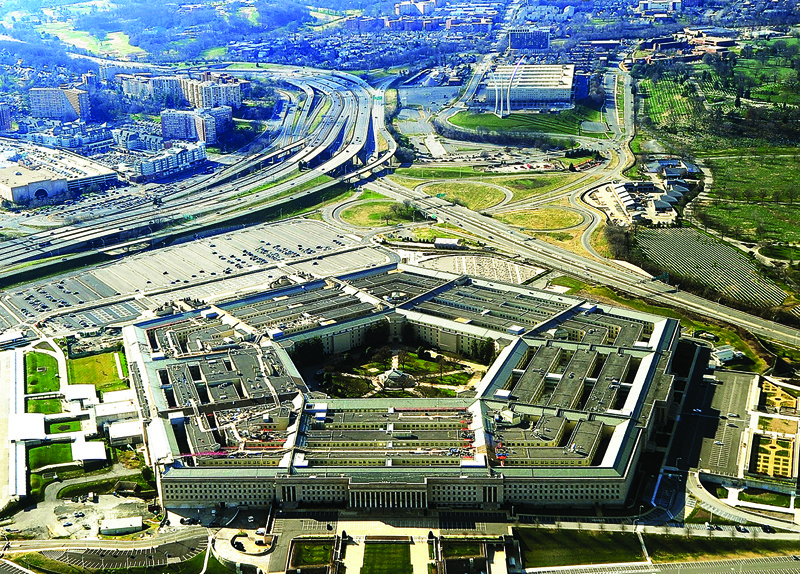 WASHINGTON: This file photo shows the Pentagon in Washington, DC. US President Joe Biden kept an effective lid on US military spending in his first budget draft, proposing to spend $715 billion, a marginal hike after sharp increases under predecessor Donald Trump. - AFP
WASHINGTON: This file photo shows the Pentagon in Washington, DC. US President Joe Biden kept an effective lid on US military spending in his first budget draft, proposing to spend $715 billion, a marginal hike after sharp increases under predecessor Donald Trump. - AFPWASHINGTON: President Joe Biden's administration on Friday unveiled a more than $1.5 trillion budget proposal that would see funding for health, education and social services eclipse defense spending, in a reversal of his predecessor's policies. The discretionary spending request for fiscal year 2022 would allocate $769.4 billion to non-defense programs, surpassing the $753 billion apportioned for defense, which was prioritized under Donald Trump but only slightly increased under Biden's proposal.
The Biden administration characterized the increase in non-defense spending as necessary to help the country recover from the COVID-19 downturn and create a more equitable economy in the years ahead. "The President's funding request makes things fairer," Treasury Secretary Janet Yellen said in a statement.
"It injects capital into communities where capital is usually hard to come by. It will make paying taxes a more seamless process for millions of Americans. And it makes sure that corporations actually pay what they owe." The nearly 16 percent increase in non-defense spending would the total to 3.3 percent of GDP, about equal to its historical average over the past three decades, Shalanda D. Young, acting director of the Office of Management and Budget (OMB), said in a letter to lawmakers.
Outside of the Defense Department, Health and Human Services would receive the most funding at $133.7 billion, a jump of more than 23 percent from the prior fiscal year, which runs from October to September. The Education Department would get a 40.8 percent funding increase that would bring its budget to $102.8 billion.
"Over the past decade, due in large measure to overly restrictive budget caps, the nation significantly underinvested in core public services, benefits and protections," Young wrote, saying the plan would be a reversal of that austerity.
The budget is a yearly undertaking for US presidents, signaling their major funding priorities, but must be approved by Congress. The plan also proposes a funding increase of more than 10 percent to $13.3 billion for the US tax authority, Treasury's Internal Revenue Service (IRS), which would help it improve its services and better monitor corporations and high earners.
It also aims $36.5 billion at schools serving poor populations, $6.5 billion for federal health research and $10.7 billion to fight the opioid epidemic. The spending bill will be considered by a Congress where Democrats hold small majorities in the House and the Senate, and where lawmakers currently are debating the $2 trillion jobs and infrastructure bill Biden unveiled last week.
Patrick Leahy, Democratic chair of the Senate Appropriations Committee, called the proposal's spending "necessary and urgent," and tied caps in federal spending over the last decade to the terrible toll wrought by the Covid-19 pandemic in the United States. "I look forward to receiving the administration's full budget in the coming weeks so that Congress can pass a budget resolution and the Senate Appropriations Committee can begin its work of marking up bills," he said in a statement.
Biden kept an effective lid on US military spending in his first budget draft, proposing to spend $715 billion, a marginal hike after sharp increases under predecessor Donald Trump. But Republican lawmakers quickly blasted the proposal as weakening the US military in the face of China's strong defense push, and demanded a larger budget. For fiscal 2022, which starts October 1 this year, Biden asked Congress to allot a total of $753 billion for defense and national security.
Of that $715 billion would go to the Pentagon, up from $704 billion budgeted for the current year but a slight fall when measured in real terms after inflation. Biden's budget supports expansion of the US Navy's fleet, amid concerns of it being outpaced by rival China, which the Defense Department considers its primary challenge. Biden is also proposing to modernize the country's nuclear weaponry and strengthen the delivery systems-bombers, submarines and missiles.
Nearly $107 billion would go to weapons- and defense-related research and development, the highest level ever, with a growing focus on hypersonic missiles, artificial intelligence, microelectronics and autonomous vehicles. But it also places an emphasis on military operations that acknowledge and address climate change. "It is vital to national security that US military installations, and the mission critical capabilities these installations support, are resilient to climate-induced extreme weather," the White House said in its spending proposal.
'Wasteful projects'
In addition, the US armed forces will get a modest pay increase under Biden's proposal. The budget "continues to improve military readiness and invest in the modernization of a more lethal force," the Pentagon said in a statement. Trump sharply pushed up the Pentagon budget beginning in fiscal 2018 after years of tight controls due to the lengthy recovery from the 2008 financial crisis. The initial budget proposal is mostly a wish list and the administration will have to hash out details with Congress beginning around mid-year, in a process that can increase or reduce the final budget.
In a statement, Senate Republican leader Mitch McConnell along with other Republican senators, blasted Biden's proposal as sending a "terrible signal" to adversaries and allies alike. "China's military investments match its desire to out-compete America and hold our military forces at risk. President Biden's defense spending cut doesn't even keep up with inflation," they said. "Talk is cheap, but defending our country is not," they said. -AFP









